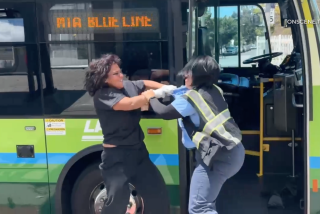Winter Clothes Protect, Conceal
- Share via
JERUSALEM — Fanny Luttinger believes that the blustery cold and penetrating wind of a February morning saved her life.
The diminutive, white-haired 82-year-old was bundled up in a thick coat and a wool hat when a suicide bomber turned the bus on which she was riding into an inferno.
“I felt things falling on my head and striking my body, but [the] heavy clothing protected me,” recalled Luttinger, clad in a flimsy hospital gown as she waited for treatment in an emergency room. In a plastic bag by her bedside were the padded yellow down-filled coat and knitted winter hat she had been wearing -- both of them scorched and shredded by sharp pieces of metal.
“I was lucky,” said Luttinger, whose family fled Nazi Germany in the 1930s. She escaped Sunday’s attack with ringing ears and deep cuts to one hand.
Eight passengers died in the powerful blast that tore through the green-and-white No. 14 bus as it was passing a park in central Jerusalem known as the Liberty Bell Garden. More than 60 others were wounded.
Israeli news reports said that shortly before the blast, security guards boarded the bus to check it, but got off without noticing anything amiss.
The same type of heavy garb that protected some riders from shrapnel can also provide cover for bombers. In winter, passengers or bus drivers are less likely to be suspicious of bulky clothing concealing an explosives belt.
Those aboard the crowded bus were the usual cross-section of people who rely on Jerusalem’s buses for daily transport -- soldiers, students, pensioners, new immigrants and the unemployed.
Among the passengers was a group of students bound for two high schools in the neighborhood. Eleven boys and girls under 18 were among the wounded.
Weeping classmates flocked to the funeral of one high school student, 18-year-old Lior Azoulay.
In the blast’s aftermath, the street was frosted with bits of glass. A man’s burned body lay crumpled by the bus’ back tires.
Ora Yairof, 52, sells candy in the park and lives near the site of the blast. She was a block away when she saw and heard the blast.
“It was like an earthquake,” she said.
Yairof heard the screams of survivors who poured out through the bus’ doors and shattered windows.
At a gas station across the street from the blast, an attendant had been pelted with bits of flesh. Rescue workers wrapped corpses in plastic sheets and lined them in a row on the sidewalk.
Michal Shalem, a 40-year-old educator, witnessed the explosion from the car she was riding in, 50 yards away. An hour later, she was teary and shaking, staring at the ruined bus with her hands cupped over her mouth in disbelief.
“The first thing that comes to mind -- one minute you’re alive, and the next, whoosh,” she said.
Shalem said she was trying to raise her three children “in a normal way,” but had forbidden them to ride buses because they are so often the target of bombings. Shimon Kadosh, who worked in the park only steps from the blast, helped pull several people from the smoke-filled bus, including a larger middle-aged man whom he hefted through a blown-out window.
Desperation, he said, gave him strength.
“I just lifted him,” said the wiry 20-year-old. “I just did it.”
Another victim, a 20-year-old soldier named Natanel Havshush, was buried less than 12 hours after the attack at Jerusalem’s military cemetery at Mt. Herzl, with grieving fellow soldiers in attendance.
At Bikur Holim Hospital in the city center, hospital administrator Yitzhak Zaldise shook his head as he watched his staff at work.
“We see so many injured from these attacks,” he said. “Everyone here does their job efficiently, but they take it into their hearts -- deep into their hearts.”
More to Read
Sign up for Essential California
The most important California stories and recommendations in your inbox every morning.
You may occasionally receive promotional content from the Los Angeles Times.












